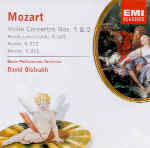My review of the first of the EMI “encore” pair of discs encompassing David Oistrakh’s incomparable performances of Mozart’s Violin Concertos can be accessed by typing Q5549 in Search Reviews. My comments there are equally applicable to this entry, which includes the last two concertos, universally regarded as the best of the quintet (Mozart, who wrote them for his own performances, preferred the Fourth). Oistrakh’s tone was bigger and rounder than most of his contemporaries, but don’t tag him with a “fat and slow” label. His artful use of vibrato often put an edge on the tone, and he played with unique intensity. These 1971 Berlin recordings sometimes have been criticized as being too thick and their tempos a shade too slow. I don’t agree. Unless you’re wedded to today’s leaner style of Mozart performance, the reduced Berlin Philharmonic here is perfectly acceptable and the timings for each movement are comparable to most of its disc competitors.
Outer movements have sufficient sparkle and zest, but in these two concertos it’s the Adagios that make the most impact, spun by Oistrakh with grace, sensuality, and passion. The Adagio of the Fifth is downright ethereal in Oistrakh’s rarified playing, ravishing in tone and with trills that linger in the mind long after the music has moved on. The fillers add up to a substantial bonus. The Rondo Concertante and the Adagio were written for Gaetano Brunetti, whose deficient taste led him to demand that Mozart supply him with alternate movements for the finale of the First concerto and, amazingly, for the great Adagio of the Fifth. The Rondo K. 373 dates from 1781 and was probably written as an encore for Brunetti. It’s a lovely work that someone at EMI must especially like since it’s also used as the filler on the first of this pair of Oistrakh’s Mozart concerto discs. Was someone asleep at the switch? The original LP box also included the great Sinfonia concertante, now found on another “encore” issue paired with the Oistrakh/Klemperer Brahms Concerto. Missing though, is the Concertone in C K. 190, which hopefully will turn up on a future release.
































